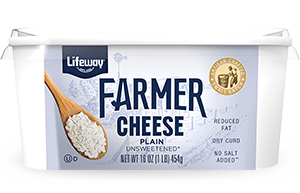Try something new with our spring-inspired pizza. Each slice is topped with farmer cheese, peppery arugula, and salty prosciutto to satisfy your taste buds with every bite.
Cultured Dairy: The Nutrition Benefits You Actually Need to Know
With increasing research linking the correlation between probiotics, gut health, and immunity, it’s no secret that the integrity of our gut is vital to our health. Although additional factors such as stress, antibiotic usage, and individual health conditions can contribute to the condition of our gut, a focus on healthy food choices is one of the easiest ways to support the microbiome.
Several studies have shown a strong association between the gut-brain-microbiota. Probiotics introduced to the gut have been found to support immunity, improve allergies, and improve digestion.
Studies have shown that reduced diversity of healthy gut bacteria during early years is associated with an increase in food allergies during school age years. In addition, kefir made from whole fat milk helps absorb key nutrients such as Vitamins A, D, E, and K. Vitamin K is important because it helps your bones absorb calcium. It’s important to know that kefir contains a special trio: vitamin D, K, and calcium – all three crucial elements to support bone health.
Prebiotics + Probiotics = a Healthy You
Prebiotics are non-living, non-digestible carbohydrates naturally found in a variety of foods. Your body actually can’t digest prebiotics, so they’re what probiotics feed off of to remain actively working in your digestive system. They help the digestive system by promoting the growth of good bacteria. Prebiotics and probiotics work together in balance to make sure our digestive system stays on track and regular. Research has found that consuming a variety of prebiotic and probiotic food sources may improve your body’s natural functions, including both your immune and digestive system.
Ingredients
- 1 lb pizza dough or 1 pre-made crust
- 1/4 cup Farmer Cheese
- 1 cup pizza sauce, divided
- 3 cups shredded mozzarella, divided
- 4 cups fresh baby arugula
- 4 tablespoons olive oil, plus more for drizzling
- 2 tsp lemon juice
- 12 slices prosciutto crudo
- Salt and pepper to taste
Directions
- Heat oven to 500 degrees F. Use a sturdy baking sheet and place it in the oven upside-down. This will give your pizza a hot surface to sit on right from the get-go, helping you get that extra-crispy crust.
- Roll or stretch out pizza dough on a floured surface (a cutting board or pizza peel).
- Leave the pizza dough on the floured cutting board or a pizza peel, or place a piece of parchment paper between the dough and the board so that it will slide into the oven easier.
- Top the pizza dough with a drizzle of olive oil, followed by the farmer cheese, then the prosciutto, and a pinch of salt and pepper.
- Slide pizza into the hot oven and bake until pizza is lightly browned and crispy. The baking time will vary depending in your oven and the size of the pizza - check every five minutes. Generally it will be 10-15 minutes total.
- Use a pair of tongs to carefully pull the finished pizza out of the oven and onto a wire cooling rack.
- Let cool for 5-10 minutes, then transfer to a cutting board.
- Top pizza with fresh arugula. Slice and serve immediately.

